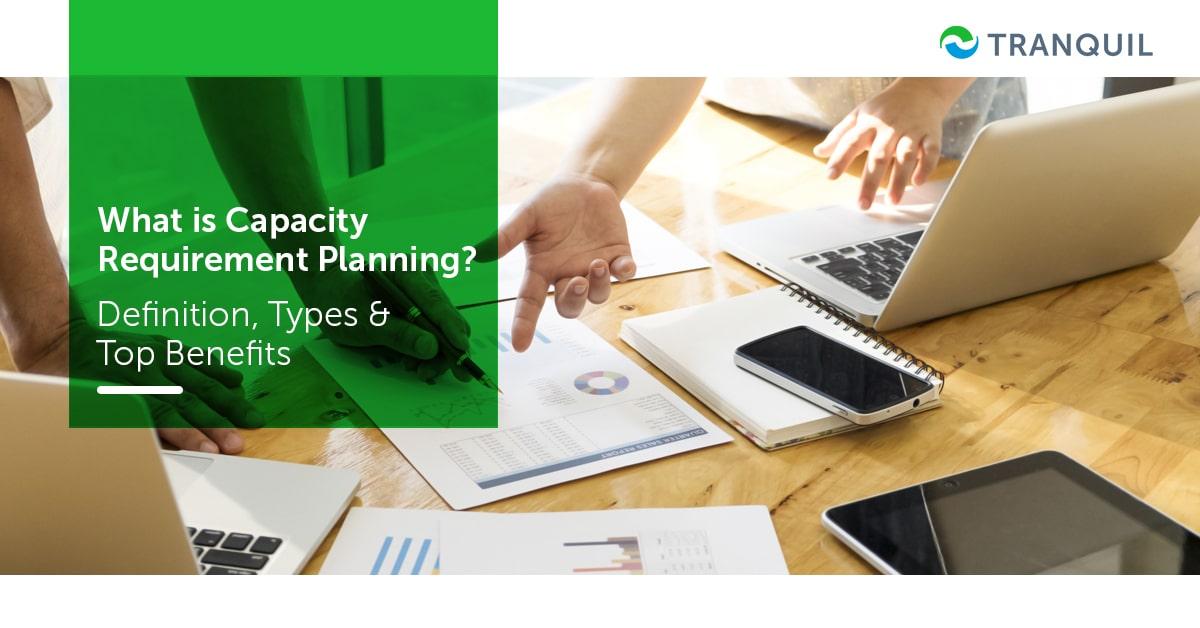
What is Capacity Requirement Planning? Definition, Types, and Top Benefits
What is Capacity Requirement Planning?
Capacity requirement planning or CRP is simply the process of figuring out the resources you will need to meet consumer demands.
It could be whether you have enough human resources, equipment, and space for the next year, seeing who is available the next week, or even for the next season.
Capacity planning is the thought process that comes before determining that you have enough people to get the job done and achieve business goals.
Lack of CRP can make it difficult to keep pace with the demand or to have unforeseen expenses later.
Obviously, deciding how many people and equipment you will need for a specific task or project is not a simple task.
The norm is to make adjustments on the fly, adding resources where and when required.
But there is a better way of doing it – capacity planning.
It is a systematic process of preparing your business for the future – immediate, near, or long-term.
With proper capacity requirement planning, you will be able to secure all that you need to complete the tasks ahead, scale, and also recognize potential supply chain bottlenecks.
ALSO READ: Benefits of ERP in Production Planning
Definition
Capacity requirements planning can be defined as the process that determines, measures, and adjusts levels of capacity.
It’s a management tool that helps the company in the efficient use of resources by increasing the accuracy of its production process.
What is the Importance of Capacity Requirement Planning?

Thanks to the organizational structures in place today, managers face numerous challenges with aspects like remote workers, autonomous teams, complex tasks that make estimations difficult, priorities that clash and shift, matrix structures, and more.
Staying on top of where your employees are assigned and what they are doing is cumbersome, and managers make estimates about the time required to complete certain projects, or if they have the right people for the job.
The right tool, like Tranquil ERP, can help you simplify capacity planning by addressing the above-mentioned challenges efficiently.
You can also streamline your business processes and enhance efficiencies across your organization.
What Inputs are Needed for Capacity Requirement Planning?
These are the inputs required for CRP, which can be gathered from the relevant files:
- Planned order releases
- Open shop order
- Routings
- Lead times
- Capacities of individual work centres
ALSO READ: Factors to Consider in Designing ERP User Interface
How to Plan Capacity Requirements?

It is an important activity for any business, and a capacity requirement plan is created depending on certain factors.
Discover the Work-level Requirements
For this, you will have to arrange workloads depending on the type and process of work, and the employee who does the task.
On completion of this, set a satisfactory service for each work, calculate the resources needed to achieve that work, and measure the amount of work done.
You can then draw up an SLA between customer and vendor.
Study the Current Capacity
It is critical that you make a thorough analysis of the current capacity.
Match the item quantification as mentioned in the SLA to the goals, and then check how the resources are used.
Note which workload consumes the maximum of each resource.
Define a Plan for Future
Work out the amount of work for certain quarters, and configure a system to satisfy service level.
ALSO READ: Tips to Choose the Best Business ERP Software Solution
What Affects Capacity Requirements Planning?
1. Product types
Complex products take longer to produce, need sophisticated equipment, and more skilled employees.
Simple products can be produced faster, and hence can be manufactured in huge volumes in a short time.
2. Finances
The business needs to have the financial capacity to purchase new machinery or hire employees
3. Skilled Workforce
Without skilled employees, or inability to hire additional or more skilled employees can hamper the production capacity
4. Equipment Capacity
Well-maintained equipment can quicken the production process.
What are the Capacity Requirements Planning Strategies?

Companies employ different strategies to help determine the quantity of raw materials, labour, and machines that would be needed over a period to produce goods and services sufficient to meet consumer demand.
Without proper planning, you may fail to fulfil consumer demands and lose the customer.
ALSO READ: What are the Key Stages of Fixed Asset Life Cycle?
1. Lead Strategy
Here the manufacturer purchases equipment to increase the capacity even before the actual demand has increased and is, therefore, an aggressive approach.
It allows the business to get a bigger market share.
However, it could lead to excess inventory if demand falls short of expectations.
2. Lag Strategy
You may have guessed that this is completely opposite to the first approach.
Here, the company adds more capacity when available capacity is full, and demand is crossing the present limits.
In short, the manufacturer increases the capacity just prior to the demand increasing, so there is no risk of excess inventory.
3. Match Strategy
Midway between lead and lag, in this approach, the manufacturer adjusts or increases the capacity in stages, based on market conditions.
4. Dynamic Strategy
This strategy is a smart one, where the manufacturer studies the actual demand and the sales forecast and increases the capacity a little before it is actually needed.
This approach is more accurate and not as risky as others.
ALSO READ: How to Choose an ERP Software to Enhance your Purchase Management?
Types of Capacity Planning
There are three main types of capacity requirement planning; together, they can make sure that you have an adequate amount of each for both short and long-term.
Workforce Capacity Planning
This strategy enables you to ensure that you have adequate human resources to fulfil consumer demand.
You need the right number of people, and with the right skills, so that they complete the tasks efficiently.
In case you need to hire more people or fire some, you will know how soon you have to make changes to account for the time taken for your recruitment and onboarding process.
Product Capacity Planning
This type of CRP allows you to determine if your business has an adequate quantity of products or resources required to fulfil deliverables.
For example – if it’s a baby needs store, you need to check stocks of diapers, baby clothes, lotions, booties, baby foods, feeding bottles, toys, cradles, cribs, and so on – the things needed to fulfil customer demand.
Tool Capacity Planning
As the name suggests, this strategy makes sure that you have the requisite tools like computers, vehicles, forklifts – whatever is required to produce and deliver your goods and services without delay.
ALSO READ: Detailed Guide on Make to Order vs Make to Stock
Benefits of Resource Capacity Planning

Let’s now look at the advantages CRP offers:
1: Reduce Costs
CRP helps you pick the most economical method of fulfilling future resource needs.
For example, if you get a new task from a customer that needs the services of a software developer.
This can be done by any developer but you have highly experienced people on your team; obviously, they need to be paid more.
With capacity planning, you can see what each employee is working on, and can change the future assignments depending on their skills and availability.
Let’s say you have one highly experienced employee who is available but is expensive; you have another employee, new, but capable – however, their availability is in a week’s time.
Now you need to decide whether it’s more economical to start immediately and pay more to the developer, or wait a week and pay less.
CRP will help you make the right decision on resource management and budgeting.
ALSO READ: What are the Challenges in ERP Implementation?
2: Ensure Availability
Make sure that you have the resources to deliver the work before you accept new assignments – CRP can help you see if you can.
You must either have people available or be prepared to hire more.
Make sure that neither is your team overworked nor do you fall short of the workforce.
Analytics and resource reporting can help you ensure that your team doesn’t get burnt out.
Continuously overworking can cause your employees’ health to deteriorate.
3: Manage Your Skills Inventory

There is a strong relationship between capacity planning and your team’s skills inventory.
This is just a record of the skills of your employees, and it’s especially helpful for tech skills.
When it comes to IT, you can list their skills like the programming languages they know, whether they are adept at only coding, or other elements like design, testing, security protocols, and more.
Similarly, when you need a lawyer, their record will tell you in what laws they specialize – international, intellectual property, inheritance, and so on.
This will help you determine if an employee has the requisite skills when you have to actually allocate them to a task.
You will need to update this inventory when the employees upgrade their skill sets.
The inventory should be checked regularly to determine if the employee skills are suitable and adequate to deliver your strategic initiatives.
If they are not, you can take corrective actions.
ALSO READ : Guide on How Do ERP Systems Work
4: Identify Skill Shortages
Let’s say you signed on for a major project but suddenly realize that you don’t have the requisite skills for your team.
Capacity planning would have shown you this beforehand, allowing you to identify the shortcomings and take the necessary actions, like:
- Ensure that you use all the skills available with your team
- Augment your team with permanent or temporary hires so that you now have the needed skills
- Provide training so that your existing members are upskilled
The skill shortage can be of different types; let’s say you need three developers skilled in Python but you only have one.
You could get the expert to coach their colleagues and fill the gap.
Managing resources with capacity planning can help you forecast what your training requirements could be.
Determine what work you are likely to be doing in the near future, and support your employees so that they can develop their skills and deliver the goods.
ALSO READ : Ways to Improve ERP with AI
5: Book Resources
Make use of organizational systems like Tranquil ERP that allows you to allocate resources to projects directly.
It is especially helpful in a matrix structure where several project and operational teams depend on the same pool of employees.
When an employee is booked, it shows as such, and this helps everyone plan more efficiently.
You can use CRP to identify teams or employees who are overworked or underworked, as well as any conflicts.
With competition being intense today, random unplanned allocation of human resources won’t cut it anymore.
Managers need to use their employees strategically so that the company is well prepared to deliver projects efficiently.
To Sum Up
Tranquil ERP helps in capacity requirement planning by determining current production capacity and adjusting it to fulfil consumer demand.
You get a clear idea of what can hamper your operations in the near and distant future, and how you can overcome these challenges.
It gives you real-time data and optimizes your production planning, offering options to fulfil consumer orders in time.
Capacity planning is an invaluable tool that will help you strike a balance between finding the right people and allocating them in the right way.
Tranquil ERP is a robust and efficient ERP system that can help you achieve your business goals through automation and streamlining of your business processes, and boosting employee productivity. It can help you save time, money, and effort, and positively impact your bottom line, increasing profitability. If you are still unsure of getting on the bandwagon, give us a call to schedule a demo – or shoot us an email. We’ll demonstrate how exactly the interface works, and our representatives will be happy to answer your queries.



